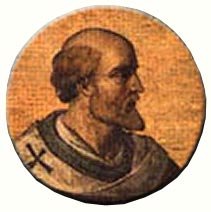- About MAA
- Membership
- MAA Publications
- Periodicals
- Blogs
- MAA Book Series
- MAA Press (an imprint of the AMS)
- MAA Notes
- MAA Reviews
- Mathematical Communication
- Information for Libraries
- Author Resources
- Advertise with MAA
- Meetings
- Competitions
- Programs
- Communities
- MAA Sections
- SIGMAA
- MAA Connect
- Students
- MAA Awards
- Awards Booklets
- Writing Awards
- Teaching Awards
- Service Awards
- Research Awards
- Lecture Awards
- Putnam Competition Individual and Team Winners
- D. E. Shaw Group AMC 8 Awards & Certificates
- Maryam Mirzakhani AMC 10 A Awards & Certificates
- Two Sigma AMC 10 B Awards & Certificates
- Jane Street AMC 12 A Awards & Certificates
- Akamai AMC 12 B Awards & Certificates
- High School Teachers
- News
You are here
Gerbert d'Aurillac and the March of Spain: A Convergence of Cultures - Gerbert d'Aurillac

Gerbert was born around the year 945, probably near the French town of Aurillac. At a young age, he was taken to the nearby monastery, where he lived and studied for a career in the church. The abbot there was a learned and courageous man, who made certain that his pupils studied the “pagan” classics as well as the required religious texts. And so young Gerbert learned Greek and Latin, and to love Plato and Vergil as well as the works of the early church fathers.
In the year 967, Count Borell of Barcelona visited the monastery on retreat. When he left, the abbot asked him if there were men in Spain versed in the [liberal] arts. When Borell assured him that the Spanish March sheltered several monasteries with vast libraries and many active scholar-monks, the abbot asked the count if he would take the young Gerbert back to Catalonia with him, as he had exhausted the scholarly resources of Aurillac. Borell agreed, and Gerbert’s new life began.
Gerbert’s official biographer, his student Richer of Rheims, tells us that Gerbert studied in the monastery at Vich. But modern scholars agree that, to learn the things he did, he must have spent some time at the fabulous monastery at Ripoll.
The abbey of Santa Maria de Ripoll, high in the mountains of northeastern Spain, was the jewel of Catalonia. It was established as a center of religious and intellectual life in the 9th century by Count Wilfred the Hairy, the acknowledged founder of Catalonia, and its library was legendary. It contained many liturgical books, including beautiful examples of calligraphy, Visigothic texts (one from the 9th century describes how to compute the date of Easter) and Mozarabic documents, including Arabic translations of Boethius’ Arithmetica. During the 10th century, at the time when Gerbert would have visited Ripoll, the monks there were translating Arabic works into Latin. And so the young Gerbert did indeed have access to many wondrous new ideas. Richer reports that when Gerbert was taken to meet Pope John XIII and, later, the Holy Roman Emperor Otto I, they were astonished at his knowledge of science and mathematics.

The Abbey of Santa Maria de Ripoli
Betty Mayfield, "Gerbert d'Aurillac and the March of Spain: A Convergence of Cultures - Gerbert d'Aurillac," Convergence (August 2010)




